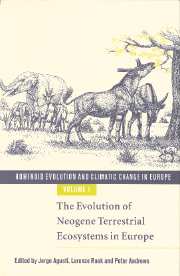Book contents
- Frontmatter
- Contents
- List of contributors
- Acknowledgements: The European Science Foundation
- 1 Introduction
- PART I Palaeogeography of the circum-Mediterranean region
- PART II Miocene mammalian successions
- 5 A critical re-evaluation of the Miocene mammal units in Western Europe: dispersal events and problems of correlation
- 6 Large mammals from the Vallesian of Spain
- 7 Trends in rodent assemblages from the Aragonian (early–middle Miocene) of the Calatayud-Daroca Basin, Aragon, Spain
- 8 The Late Miocene small mammal succession from France, with emphasis on the Rhône Valley localities
- 9 Late Miocene mammals from Central Europe
- 10 An overview on the Italian Miocene land mammal faunas
- 11 The Miocene large mammal succession in Greece
- 12 Chronology and mammal faunas of the Miocene Sinap Formation, Turkey
- 13 The Late Miocene small mammal succession in Ukraine
- PART III Palaeoenvironments: non-mammalian evidence
- PART IV Palaeoenvironments: mammalian evidence
- Index
13 - The Late Miocene small mammal succession in Ukraine
from PART II - Miocene mammalian successions
Published online by Cambridge University Press: 15 December 2009
- Frontmatter
- Contents
- List of contributors
- Acknowledgements: The European Science Foundation
- 1 Introduction
- PART I Palaeogeography of the circum-Mediterranean region
- PART II Miocene mammalian successions
- 5 A critical re-evaluation of the Miocene mammal units in Western Europe: dispersal events and problems of correlation
- 6 Large mammals from the Vallesian of Spain
- 7 Trends in rodent assemblages from the Aragonian (early–middle Miocene) of the Calatayud-Daroca Basin, Aragon, Spain
- 8 The Late Miocene small mammal succession from France, with emphasis on the Rhône Valley localities
- 9 Late Miocene mammals from Central Europe
- 10 An overview on the Italian Miocene land mammal faunas
- 11 The Miocene large mammal succession in Greece
- 12 Chronology and mammal faunas of the Miocene Sinap Formation, Turkey
- 13 The Late Miocene small mammal succession in Ukraine
- PART III Palaeoenvironments: non-mammalian evidence
- PART IV Palaeoenvironments: mammalian evidence
- Index
Summary
Introduction
Taxonomic analysis of widespread groups of small-sized mammals in Eurasia (with special reference to Cricetidae, Arvicolidae, Muridae, Spalacidae and Dipodidae of rodents, and Palaeolaginae, Ochotonidae and Leporidae of lagomorphs, as well as some insectivores, from Ukrainian localities) has characterized known mammalian complexes and allocated several new ones from Middle Sarmatian up to Early Pleistocene (Table 13.1).
This period of time encompasses about 10 million years. An important feature of most localities is the fact that continental deposits are enclosed within marine layers of the regional stages of Sarmatian, Meotian and Pontian. Their fixed position in the conventional stage scheme is a reliable basis for their correlation with the continental scale MN zones. It is a common practice in Eastern Europe to arrange the periodicity of development of faunas by means of faunistic complexes. Faunas of the Late Miocene are the least investigated, and about 10 Late Miocene sites have been analysed here. This has resulted in us recognizing six Vallesian–Turolian complexes based on small mammal distributions.
Grytsivsky mammalian complex
Fossil remains of the fauna are found in karst deposits near the villages of Grytsiv and Klymentovychi in the Khmelnytsky region (see Fig. 13.1). The sediments are precisely dated as Novomoskovsky layers of Bessarabian. That corresponds to a bottom horizon of Middle Sarmatian (Topachevsky et al., 1996).
- Type
- Chapter
- Information
- Hominoid Evolution and Climatic Change in Europe , pp. 265 - 272Publisher: Cambridge University PressPrint publication year: 1999
- 1
- Cited by



